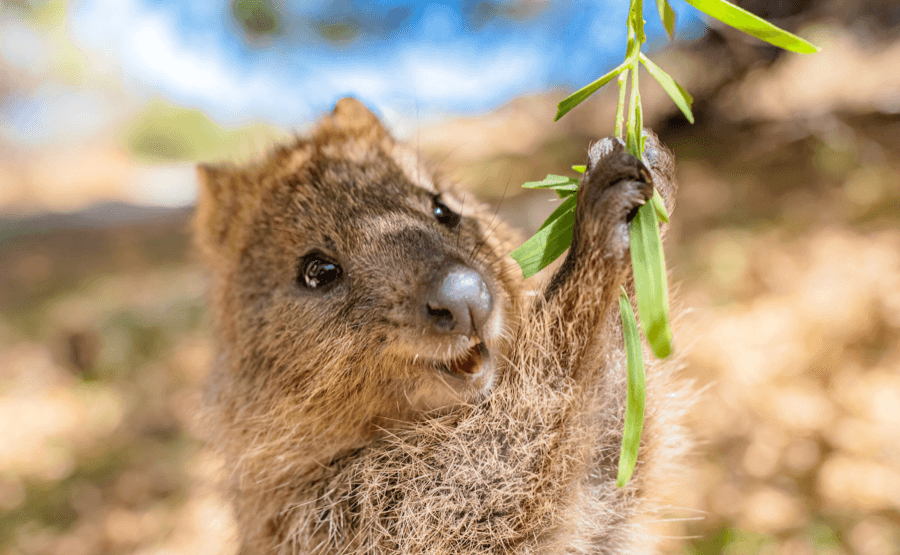Western Australia’s vast landscapes host an array of unique wildlife species that have evolved in isolation, developing remarkable adaptations to survive in challenging environments.
For travelers road-tripping WA in one of our 4WD campers, encountering these animals offers more than just photo opportunities; it provides insights into Australia’s evolutionary history and the urgent need for conservation.
Overview of Western Australia’s Wildlife
From the arid desert interior to the pristine coastline, Western Australia’s diverse ecosystems support an incredible variety of wildlife. The state’s isolation has resulted in high levels of endemism, meaning many species are found nowhere else on Earth.
According to the Department of Biodiversity, Conservation and Attractions, the region supports thousands of native species, many of which face increasing challenges from habitat loss and introduced predators.
Notable ‘Weird’ Animals
Feral Camels: An Unexpected Australian Icon

What many visitors don’t realize is that Australia is home to the world’s largest population of wild camels. These desert dwellers, originally imported in the 19th century, have adapted remarkably well to Western Australia’s arid conditions.
In the early 20th century, as many cameleers left and motorized transport became common, some released their camels into the wild. Adapted to Central Australia’s harsh conditions, these camels grew into a significant feral population.
By 2008, their numbers reached about one million, with projections indicating they could double every 8–10 years, threatening local ecosystems and cultural sites. In response, a management program was initiated in 2009, reducing the population to around 300,000 by 2013.
Recent estimates suggest over 300,000 feral camels roam the state, with numbers growing by approximately 10% annually. While these impressive animals fascinate visitors, they pose significant challenges to native ecosystems.
Quokkas: The World’s Happiest Animal
Perhaps Western Australia’s most famous resident, the quokka has earned international acclaim as the “happiest animal on Earth.” These small marsupials, primarily found on Rottnest Island and Bald Island near Albany, face vulnerable status due to habitat loss and predation.
Recent conservation efforts have helped stabilize their populations, particularly on Rottnest Island, where they’ve become a beloved tourist attraction.
Numbats: Western Australia’s Stripe-backed Symbol
The numbat, Western Australia’s animal emblem, is one of the most distinctive marsupials in the world. These specialized insectivores can consume up to 20,000 termites daily with their remarkably long tongues.
Currently endangered, numbats persist in only a few protected areas, with dedicated conservation programs working to ensure their survival.

Bilbies: Night-time Navigators
These nocturnal marsupials, often called “rabbit-eared bandicoots,” captivate visitors with their long ears and pointed snouts. Despite their vulnerable status, successful conservation efforts have maintained several populations in Western Australia.
Their ability to survive in arid conditions makes them a testament to Australian wildlife’s resilience.
Saltwater Crocodiles: Ancient Predators
The northern regions of Western Australia are home to these impressive apex predators. Growing to over 7 meters in length, saltwater crocodiles command respect and caution from visitors. Their presence in coastal and riverine areas requires travelers to stay alert and follow local safety guidelines.
Safety Considerations
When encountering Western Australia’s wildlife, remember these essential guidelines:
- Stay alert in wildlife areas and maintain safe distances from all animals
- Never feed native wildlife, as it can harm their natural behaviors
- Follow local warning signs and ranger advice, particularly in crocodile country
- Exercise caution when driving in remote areas, especially at dawn and dusk
Conservation Status and Future Outlook
Recent conservation initiatives, including Western Australia’s “Plan for Our Parks,” aim to expand protected areas by 5 million hectares by 2024. This ambitious project aligns with global conservation targets and offers hope for the region’s unique wildlife.
Conclusion
Western Australia’s distinctive wildlife offers visitors unparalleled opportunities to witness some of the world’s most unique animals in their natural habitat. By understanding and respecting these creatures, travelers can contribute to their preservation for future generations.
As you explore this remarkable region, remember that each encounter with these amazing animals is a privilege and an opportunity to support their conservation through responsible wildlife tourism.
Sources:


